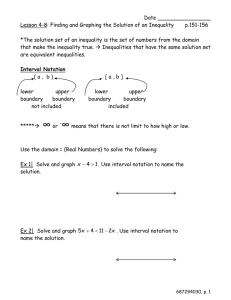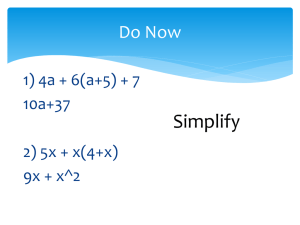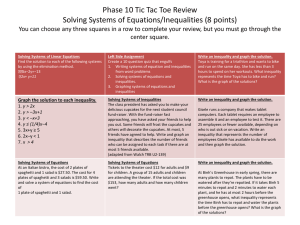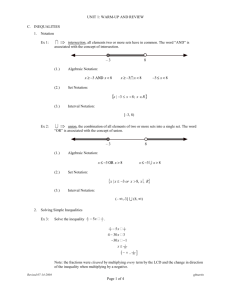Solving Absolute Value Equations
advertisement
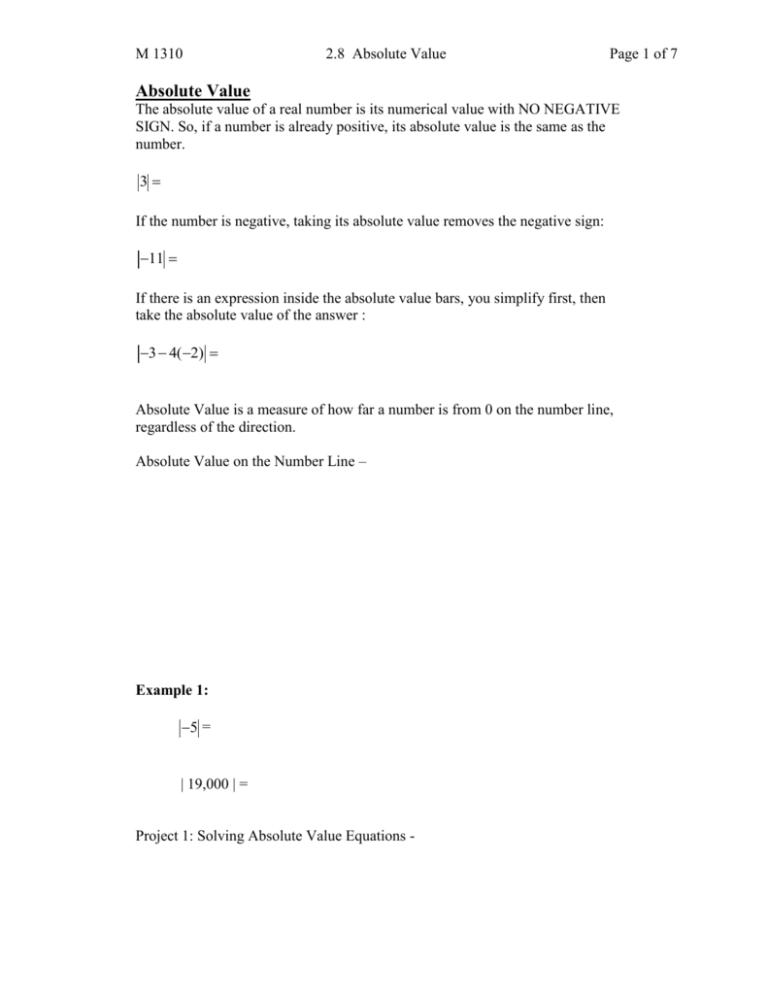
M 1310 2.8 Absolute Value Page 1 of 7 Absolute Value The absolute value of a real number is its numerical value with NO NEGATIVE SIGN. So, if a number is already positive, its absolute value is the same as the number. 3 If the number is negative, taking its absolute value removes the negative sign: 11 If there is an expression inside the absolute value bars, you simplify first, then take the absolute value of the answer : 3 4( 2) Absolute Value is a measure of how far a number is from 0 on the number line, regardless of the direction. Absolute Value on the Number Line – Example 1: 5 = | 19,000 | = Project 1: Solving Absolute Value Equations - M 1310 2.8 Absolute Value Example 2: Find all possible solutions to the following equations: Page 2 of 7 | x | 8 | x | 3 | x | 0 | x | 2 Now, let's make the equations more complicated. Motivation: The distance from your outdoor faucet to the farthest corner of your yard is 58 feet. You have a 25 foot hose. How far does the sprinkler have to reach to get to plants in the far corner? A model is x 25 58 How do I solve? Rules for absolute value equations 1. Isolate the absolute value expression on one side and a number on the other by adding or subtracting first, then multiplying or dividing. 2. If the resulting equation is absolute value equals a positive number, rewrite into the two equivalent equations. These equations do NOT have absolute value signs! 3. If the resulting equation is absolute value equals 0, set the expression in the absolute value equal to 0 and solve. 4. If the resulting equation is absolute value equals a negative number, there is no solution, you can stop here and state “no solution” M 1310 The Sprinkler Example: 2.8 Absolute Value x 25 58 Example 3: Find the solution to the equation. 2x 4 8 Example 4: Find the solution to the equation. 20 2 x 4 15 Example 5: Solve 2 | x 2 | 4 32 Page 3 of 7 M 1310 2.8 Absolute Value Page 4 of 7 Absolute Value Inequalities Consider the question of the distance from your front door to the nearest fire hydrant. LESS THAN RULES Example 6: Solve the inequality and express in interval notation. a. x 5 b. x 5 Example 7: Solve the inequalities and express in interval notation. x2 5 M 1310 2.8 Absolute Value 2x 1 9 3x 1 4 GREATER THAN RULE Solve: x 5 x 5 2 4 x4 3 3 Page 5 of 7 M 1310 Example 8: 2.8 Absolute Value Solve the inequalities and express in interval notation. x3 8 x7 2 3x 2 4 2 1 4x 1 7 3x 3 3 5 Page 6 of 7 M 1310 Example 9: 2.8 Absolute Value Page 7 of 7 Solve the inequality and express in interval notation. 2 4 x4 3 3 Example 10: Solve the inequality and express in interval notation. 7 2 3x 4 Example 11: Solve the inequality and express in interval notation. 5 9 x 2 Rules for solving absolute value inequalities 1. Rearrange the equation so that you have one of the form Absolute value inequality sign number 2. Write the equivalent inequality relation or relations by the rules on the last page. Note that these equivalent inequalities no longer have absolute value signs! 3. Solve each inequality for x and express the answer in interval notation 4. If the equation is equivalent to x>3 or x< -3 type inequality, use the union sign between the two intervals in your answer.

